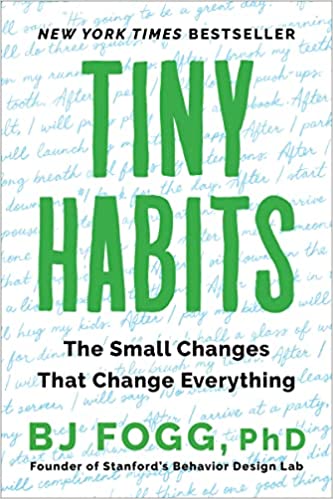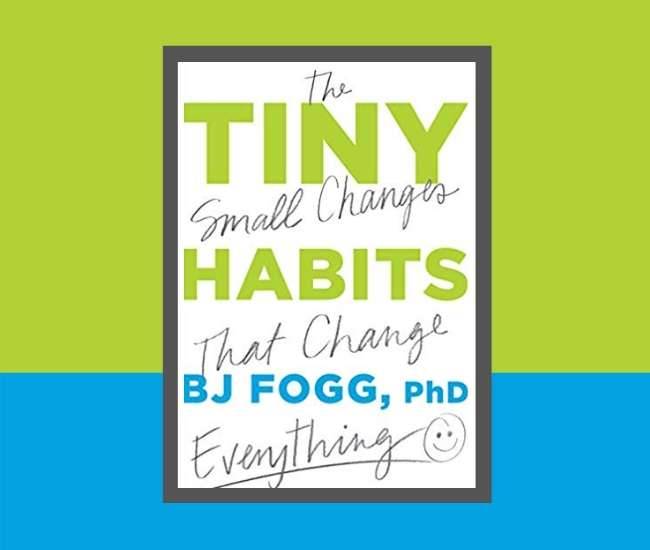Tiny Habits by BJ Fogg
Forget all those huge, sweeping resolutions you’re making for the New Year — they aren’t going to work. Either your ability or motivation is likely to defeat you. Instead, hack your behavior. This is the message in Tiny Habits: The Small Changes That Change Everything (Houghton Mifflin Harcourt) by BJ Fogg.
So how do you do that? According to Fogg, it’s a matter of behavior design. And he should know; he’s the director of the Behavior Design Lab at Stanford and has devoted a good chunk of his academic life studying behavior and habits. There’s a reason why some habits (good or bad) take root, while others, no matter how hard we try, wither and die. An important point before going further: Your failure to adopt better habits is NOT your fault! It has nothing to do with willpower; it’s simply a design issue.
B=MAP (BEHAVIOR=MOTIVATION, ABILITY, PROMPT)
Fogg explains that there are very few factors that determine whether or not a behavior becomes a habit (or even gets done at all). He calls it the Fogg Behavior Model, and it consists of a graph that shows the relationship between three factors: motivation, ability and prompt. The first two are described as continuums. Your motivation can be anywhere between non-existent and “OMG I’ll die if I don’t do this thing right now!” Your ability to do something ranges from being impossible to easy as breathing. The higher your motivation to do a behavior and the easier it is to do, the more likely you are to do it, so long as there is something prompting you. This can be an environmental or situational cue, like spotting a lion about to spring at you, or a cue that you’ve designed, such as: Every time I get in the car, I’ll put on my seatbelt.
The relationship between these three factors is the key to designing a behavior that will stick and become a habit. Let’s look at two extremes of behavior. If something is hard to do, but you are highly motivated to do it, you will do it. Think life-or-death situations where average people save lives, accomplishing feats they could never ordinarily do. If, however, something is hard to do, and your motivation is nil, well, that’s why a lot of us abandon our New Year’s resolutions on January 2. The solution, then, for low motivation is not to beat yourself up for lack of willpower. (Or, for that matter, try to drive “flight or fight” action through stressful methods.) No. The problem lies in the behavior you’re trying to adopt — it’s simply too hard to do given your motivation level and current abilities. That’s where “tiny habits” come in.
BREAKING IT DOWN TO TINY
We’re all familiar with the recommended way of achieving any goal, right? Break it down into smaller tasks. And make them actionable. The same can be done with behavior. If your New Year’s resolution is to get in shape, you will likely fail. Why? Because (a) it’s vague and (b) either your ability or motivation will prevent you from achieving it. But if your New Year’s resolution is specific (reduce my BMI to the “acceptable” zone), and you start with forming a tiny habit to achieve that goal, you will be able to build on that success to behaviors that today you would find difficult doing (or motivating yourself to do).
Fogg recommends you make that initial tiny habit ridiculously easy. He gives the example of the genesis for one of his own habits: every time he went to the bathroom, he did a wall push-up before resuming his other activities. Notice how he designed a prompt (going to the bathroom) and assigned the behavior to a situation where it’s convenient (he’s already standing up, so motivation is less of an issue) and that it’s ridiculously easy to do, so ability is less of an issue as well. Now, you might be thinking, hmmm. I go to the bathroom, what, four or five times a day? Four or five wall push-ups aren’t gonna do much.
But don’t dismiss the power of a tiny habit, because it’s the success of adopting it that will lead you to the next, and the next, in ways that really add up. Not to mention that once you’ve done that push-up, you might as well do a couple more because (a) you’re feeling good about having accomplished the first one, (b) you’re already standing at the wall, and (c) it would be relatively easy to do. And that “relatively easy” will keep getting easier and easier the more strength you build. Plus, the more you do a behavior when “prompted,” the less you have to think about it and the more you will do it on autopilot. That’s a habit.
This is just one small example of how Fogg’s method works. Tiny Habits is full of all sorts of advice to help you create, tweak and build on behaviors — and troubleshoot them when they fail to take hold as habits. He applies his method to a variety of life goals and relates numerous inspiring stories of average people who have succeeded using his model. So, if you haven’t set your New Year’s resolution yet, here’s one tiny habit you can adopt: get yourself a copy of Tiny Habits, put it somewhere convenient and every time you do (or finish doing) something else (you decide the prompt), read a couple pages. And watch your tiny habit grow into something that has the power to change your life.
Tiny Habits: The Small Changes That Change Everything is now available for purchase.
Buy this Book!
Amazon




